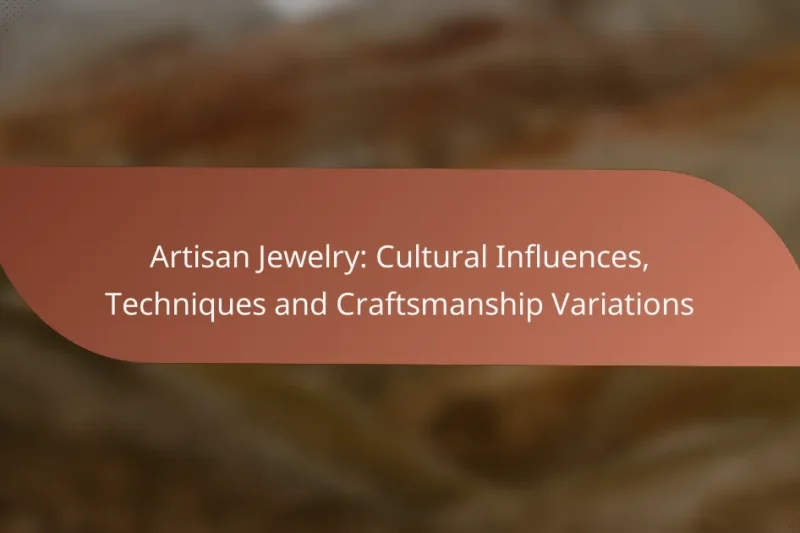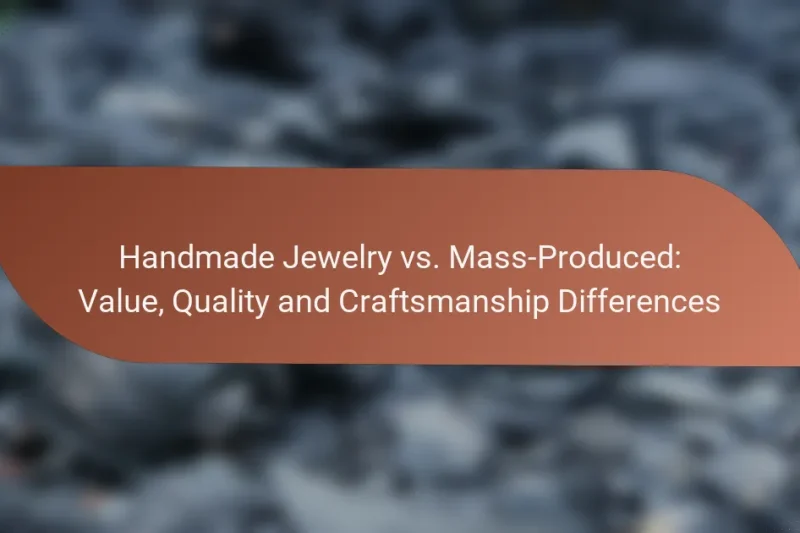Artisan jewelry offers a unique opportunity for personal expression, with styles that cater to diverse tastes … Artisan Jewelry: Craftsmanship Styles, Selection Criteria and Personal PreferenceRead more
Unique Craftsmanship in Artisan Jewelry
Artisan jewelry stands out for its unique craftsmanship, reflecting the skill and creativity of individual artisans. By choosing these pieces, you not only acquire exclusive designs but also support local talent and enjoy superior quality. Understanding the materials and the artisan’s background enhances your appreciation for each distinctive creation.
Artisan Jewelry: Local Materials, Sustainability and Unique Designs
Artisan jewelry stands out for its unique designs and commitment to sustainability, often utilizing locally sourced … Artisan Jewelry: Local Materials, Sustainability and Unique DesignsRead more
Artisan Jewelry: Quality Indicators, Craftsmanship Styles and Techniques
Artisan jewelry is distinguished by its quality indicators, such as material authenticity and craftsmanship precision, which … Artisan Jewelry: Quality Indicators, Craftsmanship Styles and TechniquesRead more
Artisan Jewelry: Techniques, Durability and Longevity
Artisan jewelry stands out for its unique craftsmanship and meticulous attention to detail, offering a stark … Artisan Jewelry: Techniques, Durability and LongevityRead more
Artisan Jewelry: Cultural Influences, Techniques and Craftsmanship Variations
Artisan jewelry is a vibrant expression of cultural heritage, reflecting the unique traditions and artistic values … Artisan Jewelry: Cultural Influences, Techniques and Craftsmanship VariationsRead more
Handmade Jewelry vs. Mass-Produced: Value, Quality and Craftsmanship Differences
The debate between handmade jewelry and mass-produced alternatives highlights significant differences in value, quality, and craftsmanship. … Handmade Jewelry vs. Mass-Produced: Value, Quality and Craftsmanship DifferencesRead more
Artisan Jewelry: Craftsmanship Evolution, Historical Trends and Modern Techniques
Artisan jewelry has undergone a remarkable evolution, merging ancient craftsmanship with modern design techniques. This transformation … Artisan Jewelry: Craftsmanship Evolution, Historical Trends and Modern TechniquesRead more
How to choose artisan jewelry for unique craftsmanship?
Choosing artisan jewelry for its unique craftsmanship involves understanding the materials, the artisan’s background, and the design’s distinctiveness. Prioritize these factors to ensure you select pieces that reflect true artistry and quality.
Consider the materials used
The materials in artisan jewelry significantly impact its quality and uniqueness. Look for pieces made from high-quality metals like sterling silver, gold, or platinum, and consider gemstones that are ethically sourced or locally mined.
Additionally, some artisans use unconventional materials such as wood, resin, or recycled elements, which can enhance the piece’s character. Always inquire about the origin and treatment of materials to ensure durability and authenticity.
Evaluate the artisan’s background
Understanding an artisan’s background can provide insight into their craftsmanship and style. Research their training, experience, and any awards or recognitions they may have received, as these factors often reflect their skill level.
Many artisans share their stories through websites or social media, which can give you a sense of their creative process and philosophy. Engaging with the artisan directly can also enhance your appreciation for the piece you are considering.
Assess design uniqueness
Unique designs are a hallmark of artisan jewelry, setting it apart from mass-produced items. Look for distinctive shapes, patterns, and techniques that showcase the artisan’s individual style and creativity.
Consider how the design aligns with your personal taste and whether it tells a story or conveys a message. Limited edition pieces or custom designs can offer even more exclusivity, making your selection truly one-of-a-kind.
What are the benefits of buying artisan jewelry?
Buying artisan jewelry offers unique advantages, including supporting local artisans, accessing exclusive designs, and enjoying higher quality craftsmanship. These benefits make artisan pieces not just accessories, but meaningful investments in creativity and skill.
Support local artisans
Purchasing artisan jewelry directly supports local craftsmen and women, helping to sustain their livelihoods and preserve traditional skills. By choosing handmade pieces, you contribute to the local economy and foster community growth.
Many artisans source materials locally, which can further enhance the economic impact of your purchase. This connection to the community often results in a more personal shopping experience, where you can learn about the artist’s story and inspiration behind each piece.
Access to exclusive designs
Artisan jewelry often features unique designs that you won’t find in mass-produced items. Each piece reflects the individual style and creativity of the artisan, allowing you to express your personal taste in a distinctive way.
Many artisans offer custom options, enabling you to collaborate on a design that perfectly suits your vision. This exclusivity not only enhances your collection but also ensures that your jewelry is one-of-a-kind.
Higher quality craftsmanship
Artisan jewelry is typically crafted with a focus on quality and attention to detail, often using traditional techniques passed down through generations. This dedication to craftsmanship results in durable pieces that can withstand the test of time.
Unlike mass-produced jewelry, which may use lower-quality materials and construction methods, artisan pieces often incorporate ethically sourced gems and metals. This commitment to quality ensures that your investment is both beautiful and sustainable.
Where to find artisan jewelry in the United States?
Artisan jewelry can be found in various locations across the United States, catering to diverse tastes and styles. Key places to explore include local craft fairs, online marketplaces, and specialized boutiques that focus on handmade pieces.
Visit local craft fairs
Local craft fairs are excellent venues to discover unique artisan jewelry. These events often feature local artisans showcasing their handmade creations, allowing you to see and touch the pieces before purchasing.
When attending a craft fair, look for events that are well-reviewed or have a reputation for quality. Bring cash, as some vendors may not accept cards, and be prepared to negotiate prices, as artisans often appreciate direct sales.
Explore online marketplaces like Etsy
Online marketplaces such as Etsy provide a vast selection of artisan jewelry from creators across the country. You can filter searches by style, material, and price range, making it easy to find something that fits your preferences.
When shopping online, pay attention to seller reviews and ratings to ensure quality. Consider the shipping costs and delivery times, as these can vary significantly between sellers.
Check specialized artisan boutiques
Specialized artisan boutiques focus on showcasing handmade jewelry and often curate collections from various artisans. These shops can provide a more personalized shopping experience, with knowledgeable staff who can help you find the perfect piece.
Look for boutiques in local arts districts or upscale shopping areas. Prices may be higher than at craft fairs or online, but the quality and uniqueness of the jewelry often justify the cost.
What are the pricing factors for artisan jewelry?
The pricing of artisan jewelry is influenced by several key factors, including material quality, the artisan’s experience, and the complexity of the design. Understanding these elements can help buyers make informed decisions when purchasing unique pieces.
Material quality
The quality of materials used in artisan jewelry significantly affects its price. High-quality metals like gold and platinum, as well as precious gemstones, tend to elevate the cost due to their rarity and durability. For example, a piece made with sterling silver may be more affordable than one crafted from 18k gold.
Additionally, the sourcing of materials can impact pricing. Ethically sourced or recycled materials may carry a premium, reflecting the artisan’s commitment to sustainability. Buyers should consider the material’s origin and quality when evaluating price.
Artisan’s experience
The experience level of the artisan plays a crucial role in determining the price of jewelry. Established artisans with a strong portfolio and reputation often charge higher prices due to their skill and craftsmanship. A novice artisan may offer lower prices as they build their expertise and clientele.
When purchasing, consider the artisan’s background, including their training and years in the industry. Investing in jewelry from a seasoned craftsman can ensure better quality and design, making it a worthwhile expenditure.
Complexity of design
The complexity of a jewelry design directly influences its pricing. Intricate designs that require advanced techniques and more time to create typically cost more than simpler styles. For instance, a piece featuring detailed engraving or multiple stone settings will generally be priced higher than a basic pendant.
Buyers should assess the design’s intricacy and the time investment involved. A well-thought-out design may justify a higher price, especially if it showcases unique artistry or innovative techniques. Understanding these factors can help in appreciating the value of artisan jewelry.
How does artisan jewelry compare to mass-produced jewelry?
Artisan jewelry is often characterized by its unique craftsmanship and attention to detail, setting it apart from mass-produced pieces. While mass-produced jewelry focuses on efficiency and uniformity, artisan jewelry emphasizes individuality and personal expression.
Higher personalization options
Artisan jewelry offers a wide range of personalization options that allow customers to create pieces that reflect their personal style. This can include custom designs, choice of materials, and even engraving. Unlike mass-produced jewelry, which typically comes in standard sizes and styles, artisan jewelers can tailor their creations to meet specific preferences.
For example, a customer might choose a specific gemstone or metal type that holds personal significance, resulting in a piece that is truly one-of-a-kind. This level of customization enhances the emotional value of the jewelry, making it more meaningful to the wearer.
Distinctive artistic styles
Each artisan jeweler brings their own artistic vision and techniques to their work, resulting in distinctive styles that are often not found in mass-produced items. This can include unique settings, innovative designs, and the use of unconventional materials. The creativity involved in artisan jewelry often leads to pieces that are not only wearable but also serve as art.
For instance, some artisans may incorporate traditional methods passed down through generations, while others may experiment with modern techniques to create fresh, contemporary looks. This diversity allows buyers to find jewelry that resonates with their personal aesthetic.
Greater investment value
Artisan jewelry typically holds greater investment value compared to mass-produced pieces due to its rarity and craftsmanship. As these items are often handmade and produced in limited quantities, they can appreciate over time, making them a worthwhile investment. In contrast, mass-produced jewelry tends to depreciate quickly due to its abundance and lack of uniqueness.
When considering artisan jewelry as an investment, it’s essential to assess the materials used, the reputation of the artisan, and the overall craftsmanship. High-quality pieces made from precious metals and gemstones can offer significant returns, especially if they are well-maintained and preserved.
What are the trends in artisan jewelry for 2024?
In 2024, artisan jewelry trends emphasize sustainability, personalization, and the use of innovative materials. Consumers are increasingly drawn to unique pieces that reflect their individual style while supporting ethical practices.
Emphasis on Sustainable Materials
Artisan jewelers are prioritizing eco-friendly materials, such as recycled metals and ethically sourced gemstones. This shift not only reduces environmental impact but also appeals to consumers who value sustainability in their purchases.
Look for pieces made from lab-grown diamonds or reclaimed materials, which can offer a more affordable option without compromising on quality. Many artisans are also incorporating biodegradable elements into their designs, enhancing the eco-conscious appeal.
Personalization and Customization
Personalized jewelry continues to gain traction, with many artisans offering bespoke services. Custom pieces allow customers to express their individuality, whether through engraved messages or unique design elements tailored to their preferences.
Consider options like birthstone incorporation or custom metalwork to create a piece that tells your story. This trend not only enhances the emotional value of jewelry but also fosters a deeper connection between the artisan and the buyer.
Innovative Design Techniques
Artisans are experimenting with new design techniques, blending traditional craftsmanship with modern technology. Techniques such as 3D printing and laser cutting are becoming more common, allowing for intricate designs that were previously difficult to achieve.
These innovations enable artisans to create lightweight yet durable pieces, expanding the possibilities for unique shapes and styles. Keep an eye out for jewelry that combines these techniques with traditional methods for a truly unique look.






